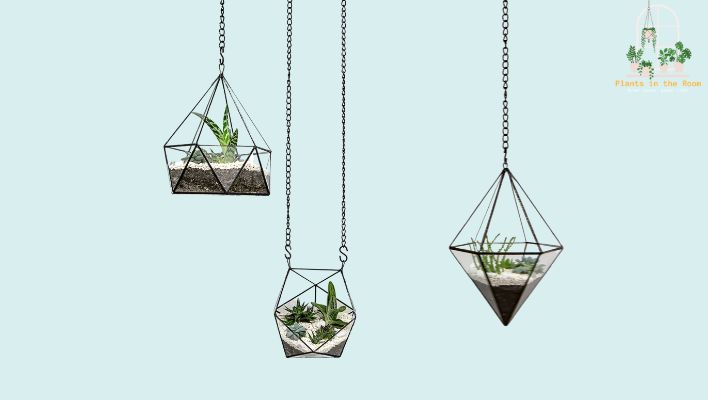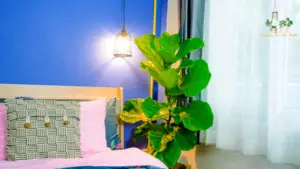This article covers the following areas –
- 1. Creative and Eco-friendly Upcycling Ideas
- 2. Fashion a Green Ceiling: Create Your Own Indoor Oasis:
- 3. Plant Placement Experiments: Think Outside the Pot
- 4. Plant Groupings: Creating a Visual Impact with Hanging Plants
- Final Thoughts
As a self-proclaimed plant enthusiast, I’ve always found that a touch of greenery brings any room to life. It’s the indoor equivalent of a fresh breath of air, filling your space with serenity and tranquility. When it comes to smaller rooms or those with limited floor space, hanging plants can be a real game changer. So today, let’s talk about some imaginative hanging plant ideas that can rejuvenate your home and make it a refreshing oasis.
Creative hanging plant ideas include using upcycled planters like teapots or coconut shells, creating a green ceiling with hanging baskets or tiered hangers, experimenting with plant placements such as in the kitchen or around windows, & creatively grouping plants using old ladders or curtain rods.
Keep reading to dive deeper into each of these ideas. I’ll cover everything from how to repurpose everyday items into unique planters to ingenious placement ideas that can enhance any room’s ambiance and innovative ways to group your plants for maximum visual impact.
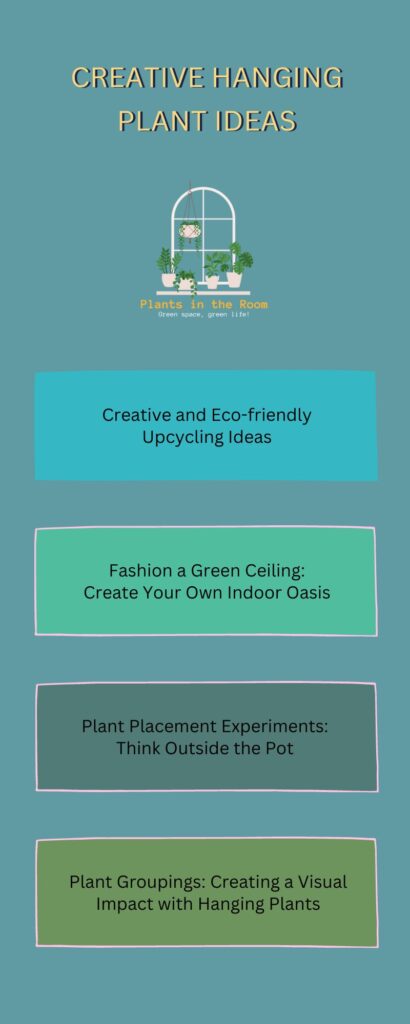
1. Creative and Eco-friendly Upcycling Ideas
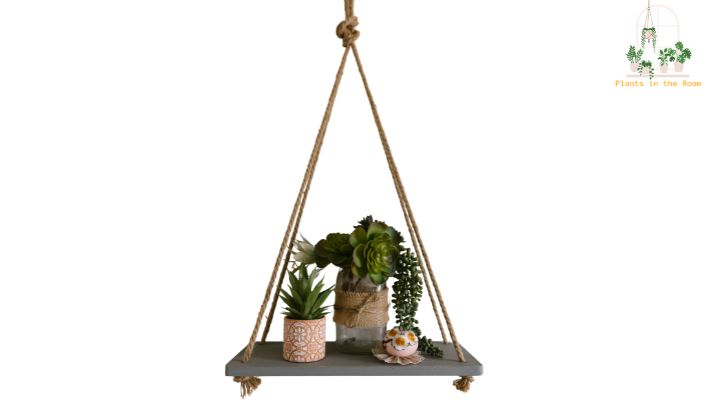
We live in a world where we are increasingly aware of our environment and the impacts of waste. That’s why I love the concept of upcycling—it’s the art of transforming unwanted items into something new and useful, reducing waste while letting your creativity flourish.
In the case of hanging plants, you can repurpose countless household items into delightful planters. It’s a fun, eco-friendly way to display your beloved green friends. Let me share some unique planter ideas I’ve tried and loved here.
1.1 Reimagine Your Old Teapots or Coffee Mugs
Chances are, you’ve got a few teapots or coffee mugs lying around that are gathering dust. Why not give them a new lease on life as a home for your plants? First, you’ll need to create a drainage hole at the bottom. You can use a drill with a ceramic bit for this; just be sure to do it slowly and carefully to avoid cracking the ceramic.
Once you have your drainage hole, attach a sturdy string or chain to the handle. When it comes to choosing your plant, consider the size of the mug or teapot. For smaller mugs, succulents or air plants work well, while larger teapots can accommodate trailing plants like ivy or pothos.
The result? A unique, eye-catching planter that will surely spark conversations when you have guests over. Plus, it’s a lovely way to keep a cherished item in use rather than stowed away in a cupboard.
1.2 Tropical Touch with Coconut Shells
Coconut shells make for beautiful, eco-friendly hanging planters. Each shell has its own unique shape and texture, which lends a rustic charm to your space. Plus, they’re perfect for adding a touch of the tropics to your home, no matter the weather outside.
To start, you’ll need a cleaned coconut shell. Cut it in half, enjoy the delicious contents, then clean it out thoroughly. Drill three or four holes into the bottom for drainage—this is crucial to prevent overwatering. Next, drill three holes along the top edge, equidistant apart. Pass sturdy cord or rope through these holes, and gather them at the top to create a hanger.
Choose plants that complement the tropical feel—orchids or bromeliads are fantastic. Remember, the goal is to create a mini tropical paradise right in your living room, kitchen, or balcony!
As a DIY tip for coconut shell planters, I would say you should seal the inside of the coconut shell with a waterproof, non-toxic sealant to make it last longer. Also, when choosing a plant, consider the size of the coconut shell. Small to medium plants are usually best unless you have a particularly large shell.
1.3 Turn Your Old Tin Cans into Hanging Planters
Here’s another eco-friendly planter idea: upcycle those old tin cans into stylish hanging planters. They’re a great size for a variety of plants and can be painted to match any decor.
You’ll need to clean out your tin cans and remove any labels to get started. Then, drill a hole or two into the bottom for drainage. Drill two more holes near the top edge opposite each other, where you’ll attach your wire or cord for hanging.
One of the best things about tin can planters is that they’re like blank canvases. You can paint them, decoupage them, or even punch designs into the sides for a lantern effect. Choose your favorite plants, and voila! You’ve given a tin can a second life as a beautiful planter.
1.4 Breathe New Life into Old Birds Cages
If you happen to have an old bird cage lying around or come across one in a thrift store, don’t pass it up. Bird cages can be transformed into stunning hanging planters that add a vintage touch to your home.
The process is pretty straightforward. Clean the birdcage thoroughly, then add a layer of pebbles or rocks for drainage at the bottom. Follow this up with good-quality potting soil. You can then add your plants—ferns, ivies, or flowering plants like begonias or geraniums work exceptionally well, creating a lush mini garden within the cage.
To hang the birdcage, use a sturdy chain or rope. Choose a location that complements the cage’s design and accommodates the plant’s sunlight needs. And just like that, you’ll have a chic, vintage-style planter that’s sure to turn heads.
Like any other planter, your birdcage will require regular watering and care. The frequency of watering will depend on the type of plants you choose, but remember—overwatering is a common mistake. Ensure the soil is dry to the touch before watering.
1.5 A Fresh Spin on Old Wine Bottles
With their sleek, cylindrical shape and translucent hues, wine bottles make fantastic hanging planters. This project is a bit more involved, but the end result is absolutely worth it.
First, you’ll need to cut the wine bottle. Several methods include using a bottle cutter or the string method. Always exercise caution when working with glass. Once the bottle is cut and the edges smoothed, add a layer of small rocks or pebbles for drainage, followed by soil and your plant.
Attach a cord or wire to the neck of the bottle for hanging. Succulents, herbs, or air plants work particularly well in wine bottle planters. Hang them in a bright, sunny spot and watch as they transform the space with a touch of elegant greenery.
Incorporating upcycled planters into your home is an excellent way to add a fresh, green look while expressing your creativity. So, why not give it a try? Start exploring your home for potential planters—I bet you’ll be surprised at what you find. And remember, the process of creating these unique plant homes is just as fulfilling as seeing the finished product. Happy planting!
2. Fashion a Green Ceiling: Create Your Own Indoor Oasis:
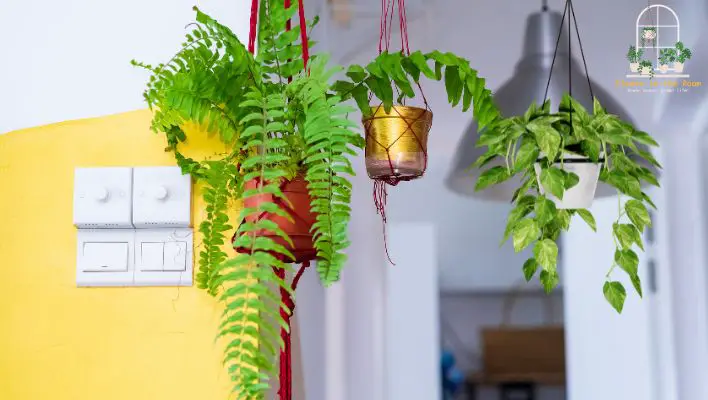
As a plant enthusiast, I often find myself dreaming of ways to bring more of the outdoors inside. One of my favorite ways to achieve this is by creating a green ceiling—a lush canopy of hanging plants that can transform any room into an indoor oasis.
This not only introduces more plants into your space but also makes use of often neglected vertical spaces. Let’s explore some creative ways to turn this dream into a reality, starting with hanging baskets, moving on to floating shelves, and finally, embracing the charm of macramé hangers.
2.1 The Magic of Hanging Baskets and Tiered Hangers
Hanging baskets and tiered hangers are fantastic ways to create a green ceiling. This method allows several plants to be suspended at different heights, creating a staggered, multi-dimensional display. Think of it as a cascading waterfall of plants right in your own home!
Start by selecting a variety of hanging baskets. Depending on your preference, these can be metal, ceramic, or even plastic. If you’d like to introduce some texture, woven or wicker baskets make a beautiful choice.
Next, it’s time to choose your plants. You’ll want to choose varieties that trail or cascade for a green ceiling. Ferns, ivy, and cascading plants like the String of Pearls or Golden Pothos are wonderful choices. Their leaves will spill out and down, creating a lush, tropical vibe.
Arrange your hanging baskets at different heights across your ceiling, creating a visually interesting and layered effect. But remember—each plant will have its own light and watering requirements, so it’s important to position them in areas that meet those needs.
While having a green ceiling is mesmerizing, keep in mind the maintenance it might need. Watering and feeding your plants are essential steps that shouldn’t be overlooked. You might find a step ladder or a long-reach watering can be helpful for this purpose. Regularly check for any signs of pests or disease, too. Remember, a healthy plant is a happy plant!
2.2 Rise Above with Floating Shelves
Floating shelves offer another great way to create a green ceiling. They’re ideal for making use of vertical wall space and can bring the greenery to eye level, which is perfect for appreciating the beauty of each individual plant.
When installing floating shelves, consider the weight of the plants and the pots they will hold to ensure they’re secured properly. It’s also important to place them near enough to natural light sources, as most indoor plants need plenty of indirect light to thrive.
You can display a mix of hanging and potted plants on these shelves for a varied, vibrant look. Trailing plants will drape down from the shelves, while the potted plants add depth and dimension. Some of my favorites to display are the Heartleaf Philodendron for its trailing beauty, the compact Pilea Peperomioides for a pop of green, and the Snake Plant for its striking, vertical leaves.
Just like with hanging baskets, you’ll need to pay attention to the care and maintenance of your plants on floating shelves. Make sure you rotate them regularly so all sides get equal exposure to light. And don’t forget to clean the leaves—dust can prevent plants from photosynthesizing effectively.
2.3 Embrace the Vintage Charm of Macramé Plant Hangers
Macramé hangers exude a certain vintage charm that’s hard to resist. With their intricate knots and designs, these hangers can add a boho-chic flair to your green ceiling.
You can purchase macramé hangers from craft stores or online, but if you’re feeling adventurous, you could even try making your own! There are numerous tutorials available that guide you through the process step by step. The great thing about this is that you can customize the design and length according to your needs.
Once your macramé hangers are ready, it’s time to choose your plants. Spider plants, trailing philodendrons, or cascading succulents like String of Bananas would look amazing, their foliage spilling out beautifully from the hangers. Hang them at different heights for a layered effect that adds depth and character to your room.
Remember, each plant in your macramé hanger has unique light, water, and care needs. Also, consider the hangers themselves—they might need a gentle cleaning from time to time to keep them looking their best.
Fashioning your green ceiling creates a fresh, vibrant living space filled with natural beauty. Plus, you’ll enjoy the calming influence and air-purifying benefits of having more plants around.
Trust me; there’s nothing quite like the feeling of being cocooned by your own hanging indoor garden—it’s a plant lover’s dream come true. I encourage you to try out these ideas and watch your home transform into a lush, green haven. Enjoy the process, and happy decorating!
3. Plant Placement Experiments: Think Outside the Pot
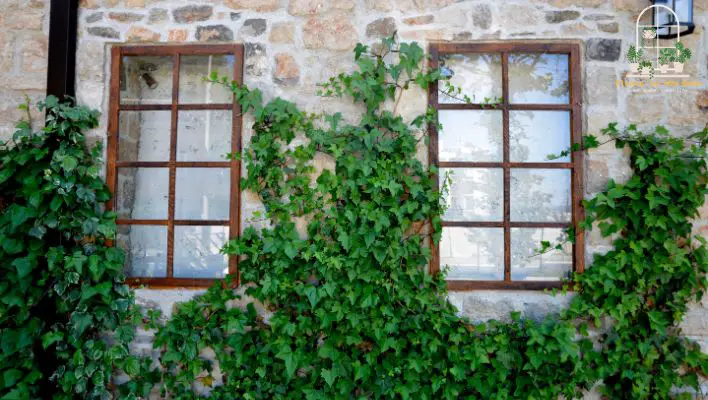
One of the joys of having indoor plants is the endless possibilities for placement. Each room in your home presents a unique opportunity to incorporate greenery in fun and creative ways.
Whether it’s in the kitchen, around your windows, or even in unexpected places like the bathroom, getting innovative with your plant placement can make a huge difference to the ambiance of your home. Let me share some of my tried and tested tips and ideas for displaying your hanging plants.
3.1 Spice Up Your Cooking Space: Plants in the Kitchen
If you haven’t considered adding hanging plants to your kitchen, now might be the time. The kitchen is a wonderful place to infuse freshness and life; hanging plants can do just that.
Herbs are a practical and aesthetically pleasing choice for kitchen hanging plants. Imagine this: you’re cooking a delicious pasta sauce, and you reach up to snip off some fresh basil from a plant hanging right there in your kitchen. Not only is this incredibly convenient, but the aroma of fresh herbs can also enhance your culinary experience.
You can use hanging baskets or tiered hangers to display your herbs. Plants like basil, parsley, thyme, and mint are excellent options. Just make sure they’re hung at a height that’s easy for you to reach and in a location that gets plenty of natural light. Most herbs prefer a sunny spot!
Remember, herbs need regular watering, but their requirements may vary. Mint, for instance, likes moist soil, whereas rosemary prefers a drier environment. So it’s crucial to water each herb according to its specific needs.
3.2 Frame Your View: Plants Around the Windows
Windows are arguably the best spots in your home for hanging plants. They generally receive plenty of light, which is ideal for many plant varieties. Plus, hanging plants around your windows can create a beautiful, natural frame, enhancing your view both inside and out.
Choose a mix of trailing and compact plants for this setting. Trailing plants like the String of Pearls or English Ivy can hang down, creating a curtain-like effect, while compact plants like Spider Plants or Peace Lilies can add lushness without obstructing the view.
Consider using a combination of hanging methods for added interest. For example, use floating shelves on either side of the window for potted plants, and hang others directly from the window frame or curtain rod.
When selecting plants for your window, it’s essential to consider the direction the window is facing. Southern windows usually get the most light, so sun-loving plants will thrive there. Northern windows receive less light, so choose plants that do well in low-light conditions, like Pothos or Philodendron.
3.3 Greenery in the Bathroom
This might seem a bit unconventional, but the bathroom can be a great spot for hanging plants. The humidity from your showers mimics the tropical environments that many houseplants originate from. Plus, plants in the bathroom can create a relaxing, spa-like atmosphere.
Choose plants that love humidity, like the Boston Fern or the Spider Plant. You can hang them from the ceiling, place them on floating shelves, or even mount them on the wall. Just ensure that they receive enough light—this might mean choosing a windowed bathroom or using artificial plant lights.
With these ideas, I encourage you to experiment with plant placement in your home. After all, part of the joy of having indoor plants is finding new, creative ways to display them. Happy planting!
4. Plant Groupings: Creating a Visual Impact with Hanging Plants
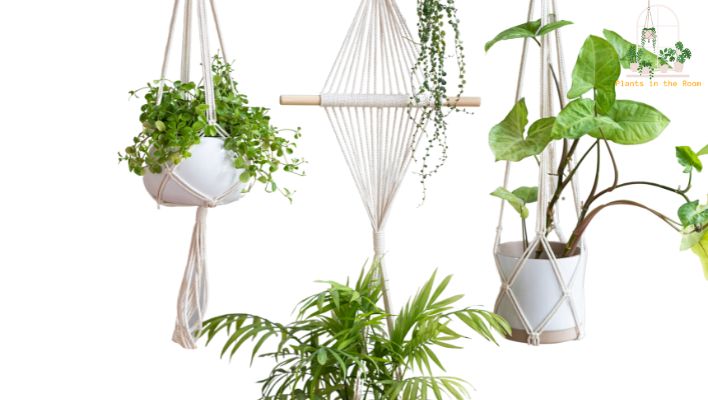
One of the secrets to achieving a truly stunning indoor plant display is to think beyond the individual plant. Grouping plants together allows you to play with different heights, textures, and colors, creating a much more visually interesting setup.
And when it comes to hanging plants, there are several unique and creative ways to group them together for maximum impact. From repurposing old ladders to turning curtain rods into a lush garden display, let’s explore some of the most exciting grouping strategies I’ve experimented with.
4.1 Climb Higher with Ladder Plant Hangers
An old ladder might seem like something to stow away in the garage or garden shed, but wait! Before you dismiss it as mere clutter, consider its potential as a creative plant hanger. I’ve found that ladders can act as versatile and innovative racks for hanging plants, providing plenty of space to group them together.
Start by securing the ladder in a safe and sturdy manner—safety always comes first. Then, hang several plants from each rung. The result? A vertical garden adds a fantastic visual appeal to any indoor space. The height variation the ladder rungs offer can help you showcase each plant individually while still creating a cohesive, clustered look.
You can play around with different types of plants and pots for a varied aesthetic. Just make sure to hang plants with similar light and water need together.
Keeping your ladder garden in top shape involves regular watering, feeding, and ensuring that the plants get adequate light. Also, pay attention to the ladder itself—it might need a little dusting or cleaning occasionally to keep it neat and tidy.
4.2 Breathe Life into Your Room with a Curtain Rod Plant Display
Here’s an idea you might not have thought of—turning a curtain rod into a hanging plant display. This setup is one of my favorites. It gives you the chance to create a living, breathing curtain of greenery, adding a calming and refreshing vibe to any room.
Install a sturdy curtain rod near a window or a well-lit area in your room for this display. Ensure the rod is secure, as it will have to bear the weight of several plants. Then, hang multiple plants from it using plant hangers or hooks. The effect is truly stunning—a lush curtain of plants that offers plenty of light for your green friends without blocking your view.
This setup works particularly well with trailing plants like Ivy, String of Pearls, or Heartleaf Philodendron, as they can cascade down, creating a dramatic visual effect.
Just like any other setup, plants on a curtain rod display will need regular care—appropriate watering, sufficient light, and periodic feeding. And don’t forget to rotate the plants every so often so they grow evenly with exposure to light from all sides.
When it comes to displaying hanging plants, the possibilities are truly endless. Grouping your plants together in creative ways, like using a ladder or a curtain rod, can help you make a real statement and transform your home into a verdant, inviting space. So, why not give these ideas a shot? I bet you’ll love the transformation as much as I do! Happy grouping!
Final Thoughts
Revamping your home with hanging plants is more than just a décor upgrade—it’s about creating a fresh, vibrant, and alive space. With the creative hanging plant ideas we’ve explored—from upcycled planters and green ceilings to unique plant placements and imaginative groupings—you have all you need to transform your space into a lush, green sanctuary.
Remember, the key is to experiment and have fun with it! So let’s grab a plant, choose a spot, and get started on this exciting indoor gardening journey together. Happy planting!

